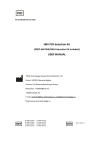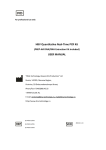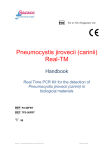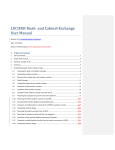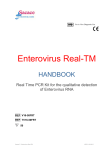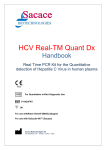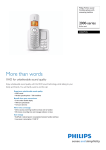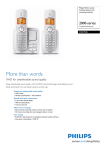Download Mycoplasma hominis Quant ENG PCR ver 21032013 - bio
Transcript
IVD For in Vitro Diagnostic Use Mycoplasma hominis Real-TM Quant Handbook Real Time PCR Kit for quantitative detection of Mycoplasma hominis REF B3-100FRT Q 100 Sacace™ Mycoplasma hominis Real-TM Quant 21.03.2013 NAME Mycoplasma hominis Real-TM Quant INTRODUCTION STDs (sexually transmitted diseases) refer to a variety of bacterial, viral and parasitic infections that are acquired through sexual activity. Some STDs, such as syphilis and gonorrhea, have been known for centuries — while others, such as HIV, have been identified only in the past few decades. STDs are caused by more than 25 infectious organisms. As more organisms are identified, the number of STDs continues to expand. Common STDs include: chlamydia, gonorrhea, mycoplasma, herpes, HIV, HPV, syphilis, gardnerella and trichomoniasis. The development of tests based on nucleic acid amplification technology has been the most important advance in the field of STD diagnosis. Because nucleic acid amplification is exquisitely sensitive and highly specific, it offers the opportunity to use noninvasive sampling techniques to screen for infections in asymptomatic individuals who would not ordinarily seek clinical care. INTENDED USE Kit Mycoplasma hominis Real-TM Quant is a test for the quantitative detection of Mycoplasma hominis in the urogenital swabs, urine, prostatic liquid and other biological materials. Sacace™ Mycoplasma hominis Real-TM Quant 21.03.2013 PRINCIPLE OF ASSAY Kit Mycoplasma hominis Real-TM Quant is based on two major processes: isolation of DNA from specimens and Real Time amplification. In real-time PCR, the fluorescent signal is generated from the presence of an olygonucleotide probe specific for target DNA sequence. The probe contains a fluorescent dye molecule on its 5’ end and a quencher molecule on its 3’ end. The probe hybridizes with one of the chains of the amplified fragment. During synthesis of a complementary chain, Taq DNA polymerase cleaves the probe due to its 5’-3’ nuclease activity. As a result, the fluorescent dye molecule becomes separated from the quencher, and the total fluorescence of reaction volume increases in direct proportion to the number of amplicon copies synthesized during PCR. The fluorescent signal is measured in each cycle of reaction, and the threshold cycle value is determined from the obtained curve. The threshold cycle is proportional to the initial number of DNA copies in a sample, and its value allows quantitative comparisons of analyzed and control samples. In Mycoplasma hominis Real-TM Quant kit there are 2 independent reactions running in parallel in each tube: the first reaction allows to detect and to quantify the specific fragment of Mycoplasma hominis (Fam/Green channel) and the second reaction detects Internal Control (Joe/Yellow/Cy3/HEX channel) present in all samples obtained from cells and allows not only to control all analysis steps, but also to estimate sample handling and storage. The result of Internal Control amplification is detected in the JOE/Yellow fluorescence channel. The DNA target selected as an endogenous internal control is a fragment of human genome (a β-globin gene fragment). It must be always present in the sample (urogenital swab) in sufficient quantities equivalent to the number of cells in the swab (103–105 genome equivalents). Thus, the use of an endogenous internal control makes it possible not only to monitor test stages (DNA extraction and amplification) but also to assess the adequacy of sampling and storage of clinical material. If epithelial swab was taken incorrectly (the number of epithelial cells is insufficient), the amplification signal of β-globin gene will be underestimated. The number of epithelial cells may be insufficient if prostate gland secretion and urine samples are used. Quantitative DNA analysis is based on the linear dependence between the cycle threshold (Ct) and the initial concentration of DNA target. Quantitative analysis is performed in the presence of DNA calibrators (samples with a known concentration of Mycoplasma hominis DNA), which are added during amplification. The results of amplification of DNA calibrators are used to construct a calibration curve, on the basis of which the concentration of Mycoplasma hominis DNA in samples determined. To minimize the effect of variation during material sampling, the quantitative results (Mycoplasma hominis DNA concentrations) are normalized to the genomic DNA quantity. Sacace™ Mycoplasma hominis Real-TM Quant 21.03.2013 MATERIALS PROVIDED Module No.1: Real Time PCR kit (B3-100FRT Q) “Mycoplasma hominis Real-TM Quant”: Real Time amplification • PCR-mix-1 FRT M.hominis Q, 1,2 ml • PCR-Buffer-FRT, 2 x 0,3 ml • Taq Polymerase, 2 x 0,03 ml • DNA-buffer, 0,5 ml • Standards: o QS1 (102 copies/sample M.hominis + β-globin), 0,1 ml o QS2 (104 copies/sample M.hominis + β- globin), 0,1 ml • Negative Control C-*, 0,2 ml *must be used in the isolation procedure as Negative Control of Extraction. MATERIALS REQUIRED BUT NOT PROVIDED Zone 1: sample preparation: • DNA extraction kit • Biological cabinet • Desktop microcentrifuge for “eppendorf” type tubes • Dry heat block • Vortex mixer • Pipettes • Sterile pipette tips with filters • 1,5 ml polypropylene sterile tubes • Biohazard waste container • Refrigerator, Freezer Zone 2: Real Time amplification: • Real Time Thermal cycler • Reaction tubes • Workstation • Pipettes (adjustable) • Sterile pipette tips with filters • Vortex mixer • Freezer, refrigerator Sacace™ Mycoplasma hominis Real-TM Quant 21.03.2013 STORAGE INSTRUCTIONS Mycoplasma hominis Real-TM Quant must be stored at 2-8°C. TaqF Polymerase must be stored at -20°C. The kit can be shipped at 2-8°C but should be stored at 2-8°C and -20°C immediately on receipt. STABILITY Mycoplasma hominis Real-TM Quant is stable up to the expiration date indicated on the kit label. The product will maintain performance through the control date printed on the label. Exposure to light, heat or humidity may affect the shelf life of some of the kit components and should be avoided. Repeated thawing and freezing of these reagents should be avoided, as this may reduce the sensitivity. QUALITY CONTROL In accordance with Sacace’s ISO 13485-Certified Quality Management System, each lot is tested against predetermined specifications to ensure consistent product quality. Sacace™ Mycoplasma hominis Real-TM Quant 21.03.2013 WARNINGS AND PRECAUTIONS In Vitro Diagnostic Medical Device For In Vitro Diagnostic Use Only The user should always pay attention to the following: • Use sterile pipette tips with aerosol barriers and use new tip for every procedure. • Store extracted positive material (samples, controls and amplicons) away from all other reagents and add it to the reaction mix in a separate area. • Thaw all components thoroughly at room temperature before starting an assay. • When thawed, mix the components and centrifuge briefly. • Use disposable gloves, laboratory coats and eye protection when handling specimens and reagents. Thoroughly wash hands afterwards. • Do not eat, drink, smoke, apply cosmetics, or handle contact lenses in laboratory work areas. • Do not use a kit after its expiration date. • Dispose of all specimens and unused reagents in accordance with local authorities’ regulations. • Specimens should be considered potentially infectious and handled in a biological cabinet in accordance with appropriate biosafety practices. • Clean and disinfect all sample or reagent spills using a disinfectant such as 0.5% sodium hypochlorite, or other suitable disinfectant. • Avoid sample or reagent contact with the skin, eyes, and mucous membranes. If skin, eyes, or mucous membranes come into contact, rinse immediately with water and seek medical advice immediately. • Material Safety Data Sheets (MSDS) are available on request. • Use of this product should be limited to personnel trained in the techniques of DNA amplification. • The laboratory process must be one-directional, it should begin in the Extraction Area and then move to the Amplification and Detection Areas. Do not return samples, equipment and reagents to the area in which the previous step was performed. Some components of this kit contain sodium azide as a preservative. Do not use metal tubing for reagent transfer. Sacace™ Mycoplasma hominis Real-TM Quant 21.03.2013 PRODUCT USE LIMITATIONS All reagents may exclusively be used in in vitro diagnostics. Use of this product should be limited to personnel trained in the techniques of DNA amplification (EN375). Strict compliance with the user manual is required for optimal PCR results. Attention should be paid to expiration dates printed on the box and labels of all components. Do not use a kit after its expiration date. SAMPLE COLLECTION, STORAGE AND TRANSPORT Mycoplasma hominis Real-TM Quant can analyze DNA extracted from: • cervical, urethral, conjunctival swabs: insert the swab into the nuclease-free 1,5 ml tube and add 0,2 ml of Transport medium. Vigorously agitate swabs in medium for 15-20 sec. • urine sediment : collect 10-20 ml of first-catch urine in a sterile container. Centrifuge for 30 min at 3000 x g, carefully discard the supernatant and leave about 200 µl of solution. Resuspend the sediment. Use the suspension for the DNA extraction. • prostatic liquid stored in “Eppendorf” tube; • seminal liquid: maintain semen for 40 min in darkness until liquefaction. Use 100 µl for the DNA extraction. It is recommended to process samples immediately after collection. Store samples at 2–8 °C for no longer than 24 hours, or freeze at –20/80°C. Transportation of clinical specimens must comply with country, federal, state and local regulations for the transport of etiologic agents. DNA ISOLATION The following isolation kit is recommended: ⇒ DNA-Sorb-A (Sacace, REF K-1-1/A). Please carry out the DNA extraction according to the manufacturer’s instructions. Sacace™ Mycoplasma hominis Real-TM Quant 21.03.2013 PROTOCOL: 1. Prepare required quantity of reaction tubes (or PCR plate) for samples and controls. 2. Prepare in the new sterile tube for each sample 10*N µl of PCR-mix-1-FRT, 5,0*N of PCRBuffer-FRT and 0,5*N of TaqF DNA Polymerase. Vortex and centrifuge for 2-3 sec. 3. Add to each tube 15 µl of Reaction Mix and 10 µl of extracted DNA sample to appropriate tube. Mix by pipetting. 4. Prepare for each run 2 standards and 1 Neg Control: prepare 4 tubes and perform QS1 and QS2 standards twice (add 10,0 µl of QS1, QS2); add 10,0 µl of DNA-buffer to the tube labeled PCR Negative Control; 5. Insert the tubes in the thermalcycler. The results are interpreted through the presence of crossing of fluorescence curve with the threshold line. M.hominis is detected on Fam/Green channel and β-globin gene on Joe/Yellow/Cy3/HEX. Amplification 1. Create a temperature profile on your instrument as follows: Rotor-type instruments 2 Temperature, °С Time Cycles Temperature, °С Time Cycles Hold 95 15 min 1 95 15 min 1 95 60 72 95 5s 20 s 15 s 5s 20 s fluorescent signal detection 15 s Cycli ng 2 60 72 2 Plate- or modular type instruments Step Cycli ng 1 1 1 5 40 95 60 72 95 60 72 5s 20 s 15 s 5s 30 s fluorescent signal detection 15 s 5 40 For example Rotor-Gene™ 3000/6000 (Corbett Research, Qiagen) For example, SaCycler-96™ (Sacace), iQ5™/iQ iCycler™ (BioRad, USA); Mx3000P/Mx3005P™ (Stratagene, USA), Applied Biosystems® 7300/7500 Real Time PCR (Applera), SmartCycler® (Cepheid) INSTRUMENT SETTINGS Rotor-type instruments (RotorGene 3000/6000, RotorGene Q) More Settings/ Channel Threshold Outlier Removal FAM/Green 0.1 10-20 % JOE/Yellow 0.1 10-20 % Slope Correct on on Plate- or modular type instruments For result analysis, set the threshold line at a level corresponding to 10–20% of the maximum fluorescence signal obtained for UG1 sample during the last amplification cycle. Sacace™ Mycoplasma hominis Real-TM Quant 21.03.2013 RESULTS INTERPRETATION The results are interpreted through the presence of crossing of fluorescence curve with the threshold line. To set threshold put the line at such level where curves of fluorescence are linear. • M.hominis DNA amplification is detected on FAM (Green) channel; • β-globin gene DNA amplification is detected on JOE(Yellow)/HEX/Cy3 channel Results are accepted as relevant if positive and negative controls of amplification and extraction are passed. Results for controls Control Stage for control Ct FAM (Green) Ct JOE(Yellow)/HEX/Cy3 Interpretation _ _ OK QS1, QS2 DNA isolation PCR Pos Pos OK NCA PCR _ _ OK NCE 1. Mycoplasma hominis DNA is detected in a sample if its Ct value is defined in the results grid in the FAM/Green channel. 2. Mycoplasma hominis DNA is not detected in a sample if its Ct value is not defined in the results grid in the FAM/Green channel (the fluorescence curve does not cross the threshold line) whereas the Ct value in the JOE(Yellow)/HEX/Cy3 channel in the results grid is defined and the quantity of human genome equivalents per reaction is greater than 103 for women and greater than 5x102 for men. 3. The result of analysis is invalid if the Ct value is not defined in the results grid (the fluorescence curve does not cross the threshold line) in the JOE channel or the number of human genome equivalents per reaction is less than 103 for women and less than 5x102 for men. In this case, PCR should be repeated starting from the DNA extraction. The DNA concentration per human genome equivalents is calculated by the following formula: log [M.hominis DNA copies x 200000] = log [M.hominis per 105 of cells] Human DNA copies N.B. In case of using urine samples and the prostate gland secretion, the number of human genome equivalents per reaction can be less than 103 for women and less than 5x102 for men. Sacace™ Mycoplasma hominis Real-TM Quant 21.03.2013 PERFORMANCE CHARACTERISTICS Analytical specificity The analytical specificity of Mycoplasma hominis Real-TM Quant PCR kit is ensured by selection of specific primers and probes as well as strict reaction conditions. The primers and probes were checked for possible homologies to all sequences deposited in gene banks by sequence comparison analysis. Nonspecific reactions were absent while testing human DNA samples and DNA panel of the following microorganisms: Gardnerella vaginalis, Lactobacillus spp., Escherichia coli, Staphylococcus spp., Streptococcus spp., Candida albicans, Chlamydia trachomatis, Neisseria gonorrhoeae, Neisseria spp., Ureaplasma parvum, Ureaplasma urealyticum, Mycoplasma genitalium, Trichomonas vaginalis, Treponema pallidum, Toxoplasma gondii, HSV of 1 and 2 types, CMV and HPV. The clinical specificity of Mycoplasma hominis Real-TM Quant PCR kit was confirmed in laboratory clinical trials. Analytical sensitivity The kit Mycoplasma hominis Real-TM Quant allows to detect M.hominis DNA in 100% of the tests with a sensitivity of not less than 500 copies/ml. The detection was carried out on the control standard and its dilutions by negative sample. Sacace™ Mycoplasma hominis Real-TM Quant 21.03.2013 TROUBLESHOOTING 1. Weak or no signal of the Positive Control. • The PCR conditions didn’t comply with the instructions. ⇒ Check the amplification protocol and select the fluorescence channel reported in the manual. 2. Fam (Green) and Joe/Yellow/Hex signal with Negative Control of extraction. • Contamination during DNA extraction procedure. All samples results are invalid. ⇒ Decontaminate all surfaces and instruments with sodium hypochlorite and ethanol. ⇒ Use only filter tips during the extraction procedure. Change tips between tubes. ⇒ Repeat the DNA extraction with the new set of reagents. 3. Any signal with Negative Control of PCR (DNA-buffer). • Contamination during PCR preparation procedure. All samples results are invalid. ⇒ Decontaminate all surfaces and instruments with sodium hypochlorite and ethanol or special DNA decontamination reagents. ⇒ Pipette the Positive control at last. ⇒ Repeat the PCR preparation with the new set of reagents. Sacace™ Mycoplasma hominis Real-TM Quant 21.03.2013 KEY TO SYMBOLS USED List Number Caution! Contains sufficient Lot Number for <n> tests For in Vitro Diagnostic Use Version Store at NCA Negative Control of Amplification Manufacturer NCE Negative control of Extraction Consult instructions for use C+ Positive Control of Amplification Expiration Date IC Internal Control * SaCycler™ is a registered trademark of Sacace Biotechnologies * iCycler™ and iQ5™ are trademarks of Bio-Rad Laboratories * Rotor-Gene™ Technology is a registered trademark of Qiagen * MX3000P® and MX3005P® are trademarks of Stratagene * Applied Biosystems® is trademarks of Applera Corporation * SmartCycler® is a registered trademark of Cepheid Sacace Biotechnologies Srl via Scalabrini, 44 – 22100 – Como – Italy Tel +390314892927 Fax +390314892926 mail: [email protected] web: www.sacace.com Sacace™ Mycoplasma hominis Real-TM Quant 21.03.2013














